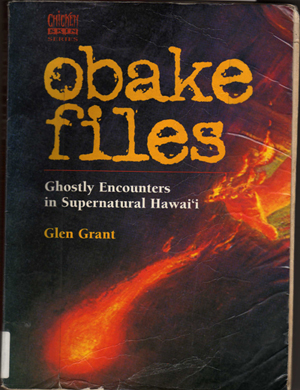
Since starting our Hawaii State Public Library Challenge Tour, we have learned a great deal about our state library system. We’ve learned about how they categorize and display books, what kinds of programs and services are commonly and uniquely offered, which branches have special collections, and that children’s books are often the bread and butter of the library system. Typically, Hawaiian books tend to do well because teachers assign them for reading, parents love the wealth of children’s books available and we all have a general interest in the culture and history of our island home. But when talking about circulation, the one unifying theme I have noticed throughout a number of libraries we’ve visited is that often the most popular books are the ones full of ghost stories. When talking about which books kids and adults check out, more often than not we will hear obake books and chicken skin tales. When we visited Liliha Public Library, the librarian there even mentioned with certain programs you practically have to drag teenagers into the building to get them to attend, but when it comes to the scary stuff the place is always packed.

When you talk about ghost stories here in Hawai’i, a lot of names and stories come to mind. One of the biggest names in the ghost story trade is Glen Grant. Grant taught for many years as a University of Hawai’i professor where he was very popular and began learning and compiling supernatural and strange occurrences. He interviewed a number of individuals, kept newspaper clippings of spiritual encounters, and researched the many myths and folk tales of ancient Hawaiians. What came about from this and the famous “Ghosts of Old Honolulu” walking tour is Obake Files.
Obake Files was recommended to me by Patti Meerians, the Branch Manager of Kailua Public Library. She used to be a student of Glen Grant, and recalled the book fondly. The book itself is essentially a collection of ancient myths, ghostly convenes and famous spiritual landmarks all found in Hawai’i. It is split into three major sections, or cabinets as Grant calls them: The Supernatural of Hawaii – Types and Styles, which compiles a wealth of supernatural stories and encounters; Haunted Hawai’i, which takes you on a tour of the haunted and mysterious venues all over the islands; and Uncanny Photographs which is a visual collection of pictures bearing eerily defined evidence.
Obake Files is really a must-have part of your Hawai’i folklore & mythology collection. And even if you are a non-believer, I think it’s a must-have part of your historical collection as well. Most of his other books contain a greater flair for storytelling—and are written in a way to emphasize the dramatic. If you like great and spooky storytelling, you may want to find another one of Grant’s books. However, what Obake Files provides are the clear-cut “facts.” Many of the accounts are brief, running less than a page, making this a great book to pick up in sporadic bouts. These are not so much “stories” as they are firsthand accounts of spooky encounters from locals and visitors in Hawai’i. Think of it as watching Ghost Hunters instead of Ghost Whisperer, to make a simple comparison. More than anything, though, this is a journey through the spiritual history of the islands. From ancient Hawaiian myths to modern day ghostly parables, Obake Files takes you on a supernatural tour of the Hawaiian Islands. Even if you’ve never had an experience, reading this book will give you pause on doing the many stupid things people have done in the book that ended up angering the unknown spirits living among us.
A word of warning for the potential reader: Since I started reading Obake Files, I have experienced a couple of strange occurrences—all in the same area and in similar half-sleepy circumstances. One of them was when I was awake, head against a desk, and I started seeing a deluge of musical notes and symbols scrolling rapidly across my plane of vision. This visualization was readily apparent and had me contemplative of its origin. Another time, stirring from half slumber I heard a woman whisper the name “Mary Chowder” to me. The name itself seems preposterous, but if anybody happens to know anything related to a “Mary Chowder” (or something similar as I may have misheard), please let me know. Or if you have personally had an interesting experience that goes beyond common sense reasoning, I’d love to hear about it here. Leave a comment!




